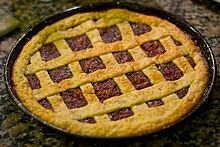Our website is made possible by displaying online advertisements to our visitors.
Please consider supporting us by disabling your ad blocker.
Pastafrola

Pasta frola or pasta frolla (Greek: πάστα φλώρα)[1][2] is a type of sweet tart common to Italy, Argentina, Paraguay, Uruguay, Egypt and Greece.[3][2] It is a covered, jam-filled shortcrust pastry dish principally made from flour, sugar and egg.[4] Common fillings include quince cheese, dulce de batata (sweet potato jam), dulce de leche, guava, or strawberry jam.[1] The covering of the tart is a thin-striped lattice which displays the filling beneath in rhomboidal or square sections. Pastafrola is most usually oven-baked in a circular shape. Most of the Greek versions of this dish are filled with sweet jam: it is considered a morning dessert.
The name of the dish comes from pasta frolla (lit. 'friable pastry'[5]), Italian for shortcrust pastry, and is similar to the Italian crostata. Italian immigrants brought it to Paraguay, Uruguay and Argentina.[6] Similar dishes include the Austrian Linzer torte and Swiss tarts with a spiced-fruit filling.[7] In Greek, the word frolla was misinterpreted as the Italian word flora.
The dish is served as an afternoon dessert (merienda) or with mate (a South American drink), but may be eaten at any time of the day.[7]
- ^ a b Πάστα φλώρα (in Greek). Argiro. Retrieved on 2019-04-25.
- ^ a b Πάστα φρόλα: έτσι λέγεται στην πραγματικότητα η πάστα…φλώρα (in Greek). INews.gr (2011-04-02). Retrieved on 2015-03-23.
- ^ ¡A merendar una pastafrola! Archived 2018-08-13 at the Wayback Machine. (in Spanish). Ella. Retrieved on 2015-03-23.
- ^ pastaflora (in Spanish). Diccionario de la lengua española (22.ª edición), Real Academia Española (2001).
- ^ Istituto Treccani, Vocabolario on line, s.v.
- ^ Pasta Frola de Dulce de Membrillo - Quince Tart Archived 2016-12-20 at the Wayback Machine. About. Retrieved on 2015-03-23.
- ^ a b Pastafrola y sus ancestros Archived 2017-09-15 at the Wayback Machine (in Spanish). La Nación (2002-07-14). Retrieved on 2015-03-23.
Previous Page Next Page


